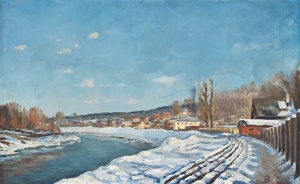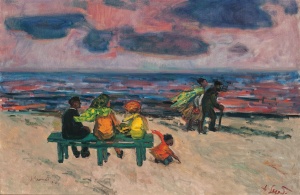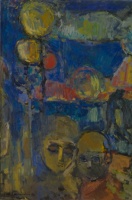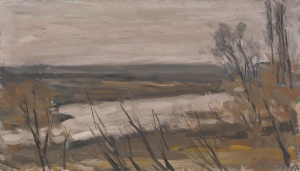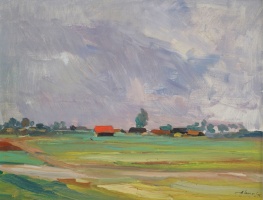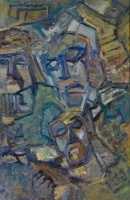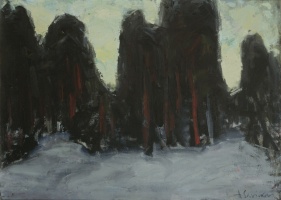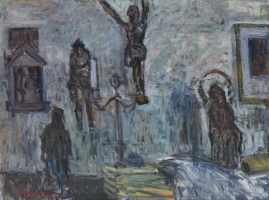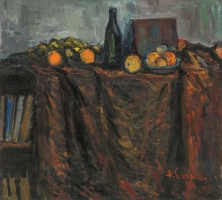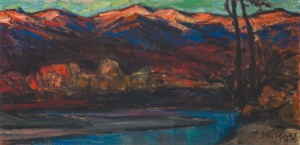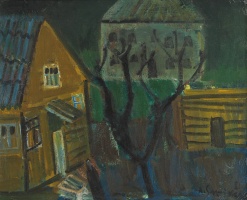
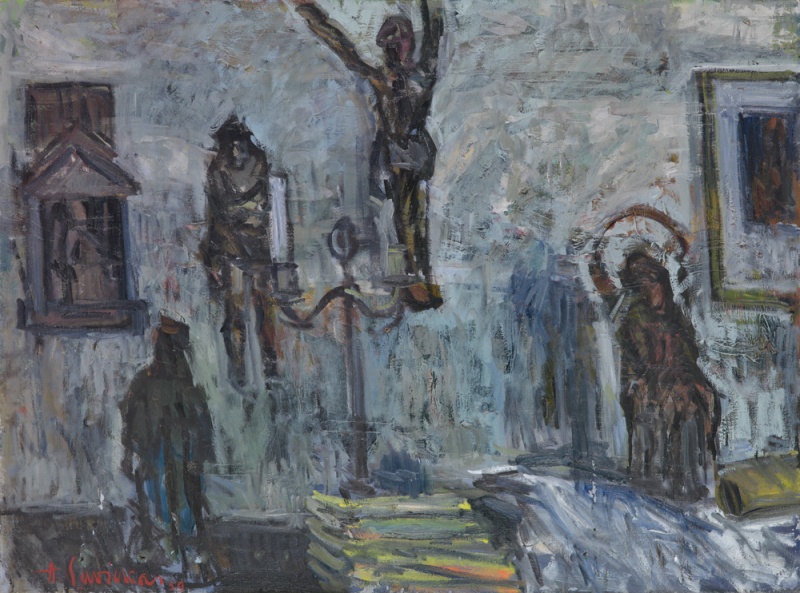

Smūtkeliai (folk sculptures of saints)
| Author: |
Augustinas Savickas (1919–2012)  |
| Created: | 1959 |
| Material: | canvas |
| Technique: | oil |
| Dimensions: | 97 × 130.50 cm |
| Signature: | bottom left: A. Savickas / 59 |
Religious themes are more frequent in the later work by Augustinas Savickas (1919–2012), although some associations occurred in the works he created in the Soviet period. Aspects of Christian culture in his pictures from that period were embodied in the form of folk sculptures that he had admired since his childhood, when he saw the reverential approach towards the ‘naive but refined masterpieces of folk art’ by his father, the writer and diplomat Jurgis Savickas. Later, the artist himself collected folk sculptures. Between 1950 and 1960, Savickas produced a series of six small paintings ‘Lithuanian Folk Sculpture. Still Lifes’. In his Motifs of Smūtkeliai (folk sculptures of saints), he used the grey shades that were popular at the time and which were very suitable for showing the beauty of worn and scuffed wooden sculptures. Lithuanian folk art was always an important source of inspiration for Savickas. Even the outlines of human figures in his ordinary compositions often recall folk sculptures. They are compact and generalised, the features on the faces are barely discernible, and the movements are conditional and stiff.
Text author Dalia Vasiliūnienė
In the context of painting in the 1950s, this musty brown picture stood out at once by its combination of colours, with dark silhouettes of wooden sculptures against a bluish-grey background painted in wide brushstrokes by mixing the paint on the canvas. The main theme of wooden sculptures of Christian saints made by country craftsmen ought to have appealed to its contemporaries. Official atheism was increasingly pushing them out of their normal environment, and museums could not always collect them, so some intellectuals gladly took in the ‘idols’ and protected them in their homes. The old bronze candlestick on a pile of books helps to create an image of a successful, educated Soviet artist, aware of the past.
Text author Giedrė Jankevičiūtė
Judaism and Christianity. Although Christianity has its roots in Judaism, there is a sharp divide between the two religions today. Judaism sees any faith as an effective tool; thus, for the Jews, a Christian church is more than just a building. It is a place where Christianity is tangible, and faith permeates the walls and space of the church. In the same way, Judaism sees its own faith as being manifested in the space of the synagogue. Therefore, since the Middle Ages, and especially after the growth of Christian art, according to the consensus of the rabbis, halakhah has forbidden Jews to visit the houses of prayer of other faiths, even just for the purpose of admiring the architecture or works of art, because a believer entering a church experiences the impact of Christianity. However subconscious this experience may be, it is incompatible with the Jewish faith and practice.
Yehudo Meier Epstein was deeply impressed by the Christian holidays that he witnessed in his childhood. Although the artist inherited from his father, a Talmudist and Hebrew teacher, a deep knowledge of Jewish scripture, and was well versed in halakhah, he could not resist the temptation to depict Catholic prayers in a church or a solemn procession with a cross, banners, lanterns, candles and hymns. Details of Christian culture also appear in the series of six small paintings ‘Lithuanian Folk Sculpture. Still-Lifes’ by Augustinas Savickas, created in the 1950s and 1960s. The religious theme here is represented by folk sculptures: the saints, figures of the Sorrowing Christ, the Crucified Christ, and the Pietà.
Text author Vilma Gradinskaitė
Source: Law firm Valiunas Ellex art album HEAVEN AND BEYOND (2016). Compiler Dalia Vasiliūnienė. Text authors Dalia Vasiliūnienė, Skaidrė Urbonienė, OBJECTS ON SHOW (2017). Compiler and author Giedrė Jankevičiūtė, STORIES OF LITVAK ART (2023). Compiler and author Vilma GradinskaitėExpositions: “Abstraction and Expressionism - Two Traditions of Vilnius Painting”, 04 – 31 July 2009, ARKA Gallery, Vilnius; “Heaven and Beyond. Works of religious art from the collection of Rolandas Valiūnas and the law firm Valiunas Ellex“, 31 May–24 September 2016, Church Heritage Museum, Vilnius (curators Dalia Vasiliūnienė, Skaidrė Urbonienė)
© LATGA, Vilnius 2024







